|
|
||||||||||||||||||||||||||||||||||||||||||||||||||||||||||
|
Please sign my Guestbook and leave feedback |
||||||||||||||||||||||||||||||||||||||||||||||||||||||||||
|
Recent Additions |
||||||||||||||||||||||||||||||||||||||||||||||||||||||||||
|
Of the churches discussed so far, only two - Hungarton and Buckminster - do not have friezes that feature faces with heads contained within square-shaped headdresses. As we have seen, the Gargoyle Master also used the device on his hitchhiker gargoyles. On every level, this is an oddity. Firstly, human faces are not very common on these friezes where grotesque is the order of the day. Secondly, they appear in considerable numbers. Thirdly, this is not a form of headdress that seemed to be have been in very common use in mediaeval times. |
|||||||||||||||||||||||||||||||||||||||||
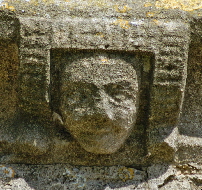 |
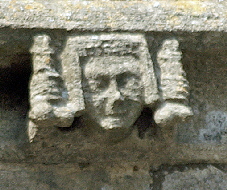 |
||||||||||||||||||||||||||||||||||||||||
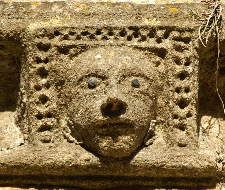 |
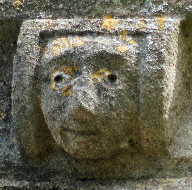 |
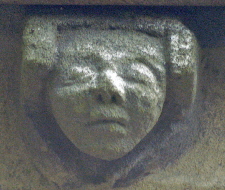 |
|||||||||||||||||||||||||||||||||||||||
|
Square-headed faces at (left to right): Ryhall (note the black eyes), Oakham, Langham, Whissendine, Cottesmore |
|||||||||||||||||||||||||||||||||||||||||
|
Our knowledge of mediaeval costume is very dependent upon funerary monuments and mediaeval manuscripts. Monuments, in particular, often have dates, which is invaluable, or commemorate aristocrats whose dates of death are sometimes known. from other sources. This headdress is not a hat as we would know it. It is a framework that surrounds a face and supports a veil that covers the rest of the head. Only girls or prostitutes would be seen in public with their hair loose. The sculpted images make the structure look very solid but in fact it was not made of solid materials at all. This is not headwear worn by peasants or ale wives. As can be seen from the photographs above, the framework was often decorated with embroidery or, in the case of the rich, embellished with pearls or other adornments. The framework was known as a “goffer” and the headdress itself as a “caul”, There were many variations on these themes and only a true expert on mediaeval costume could expound on the subject authoritatively. The goffer could have many shapes but it seems that one that curved around the shape of the head was more common than the box shape we see in these pictures and which would have required some form of supporting structure. However, it is not difficult to see how the square shape would appeal to a stonemason trying to fit a sculpture into the rectangular profile of a cornice. The significance of these square goffered veils to this narrative is that they enable us to roughly date when the masons were carrying out this work. One must assume that they were not closely attuned to female fashion but they surely reproduced what they saw. Katrina Wood, an expert in mediaeval headdresses says : “I do know of this style of headdress. It is a form of reticulated headwear from approx c1380 (not before c1350/60 and definitely not after 1410)…It is an early form of 'Hood' though not what we know today as a hood and not classed as a gable headdress either. It does look a solid structure, as this period loved squareness in headdresses. Even hair was plaited to frame the face in a square style but by the time of Richard II (1367-1400) gold “fret” (old word for net) styles like this were worn…With all the detail on these small carvings, I would say it would be a headdress worn only by those with means.” |
|||||||||||||||||||||||||||||||||||||||||
 |
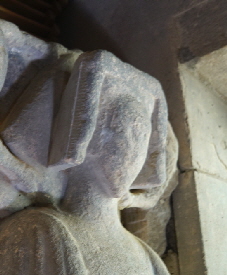 |
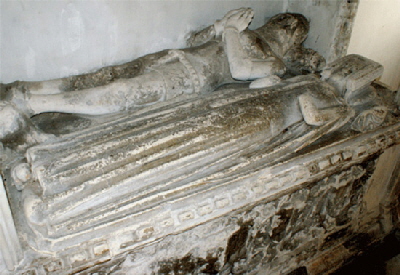 |
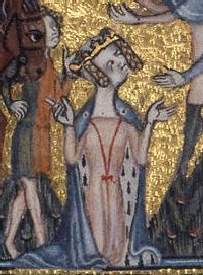 |
||||||||||||||||||||||||||||||||||||||
|
Monuments and Manuscripts showing square goffered headdresses. Left: Joan de Mohun (d.1404), Canterbury Cathedral. Second Left: Wife of William de Stockden who died sometime after 1371, Burrough-on-the-Hill, Leicestershire. Second Right: Lord Bouchier (d.1400) and his wife, Elizabeth de Coggeshall, Hasltead, Essex. Far Right: Image of Mary de Bohun, first wife of Henry IV, from the Psalter of Mary de Bohun and Henry Bolingbroke produced 1380-1385. Mary died in 1394. |
|||||||||||||||||||||||||||||||||||||||||
|
The identities of the four ladies in the pictures above bear out Katrina Wood’s assertion that the goffered headdress would be worn by high status ladies. This would seem to rule out the possibility that the stonemasons were immortalising their own wives and lovers. One of the odder features of life in mediaeval times was the so-called “sumptuary laws” which, astonishing as it may seem to modern sensibilities, dictated the dress code for men and women in the various strata of society. The death of feudalism in the post-Plague decades did not mean that the aristocracy, great or minor, was about to let the new money get above its station in the social hierarchy. Stonemasons were financially better off than the common labourers but certainly no wealthy and they would not have been able to dress their womenfolk in finery even if they had the means to do so. The Luttrell Psalter, written in the first half of the fourteenth century before the Plague and produced at Irnham just a few miles from Buckminster is celebrated for, amongst other things, its depictions of feudal life. Peasant women are always shown with their hair covered and invariably by a loose woollen wimple-style garment. None of them are shown wearing anything remotely fashionable or decorative. The Plague caused the gradual abandonment of feudalism and the rise of the well-off merchants and yeoman farmers - the very people who were increasingly bankrolling church building. It is possible that these women were the wives of the church benefactors but that begs the very obvious question of why then we don’t see their husbands also portrayed? Adding to the mystery is that women wearing goffered veils were sometimes carved on much larger scale as label stops and also inside churches. Those larger images are often adorned with decoration around the goffer, again accentuating the social status of this device. |
|||||||||||||||||||||||||||||||||||||||||
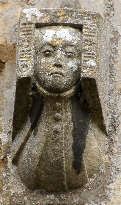 |
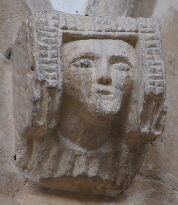 |
||||||||||||||||||||||||||||||||||||||||
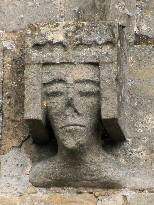 |
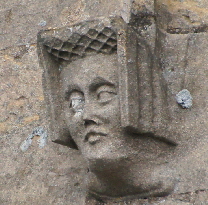 |
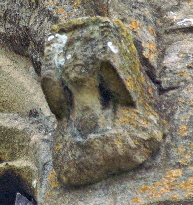 |
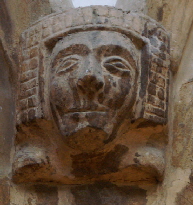 |
||||||||||||||||||||||||||||||||||||||
|
Goffered headdresses at (left to right) : Harlaxton example 1 (label stop); Harlaxton example 2 (label stop); Denton (Lincolnshire) - note the buttons.. Thurlby (Lincolnshire) label stop; Langtoft (Lincolnshire) north arcade spandrel; Tilton-on-the-Hill north arcade spandrel. |
|||||||||||||||||||||||||||||||||||||||||
|
The masons had far more scope to change the geometry of the goffers in these larger example but still chose to use a square profile. It is possible, of course, that they were influenced by the fact that less shaping of the stone block would have been required. The presence of buttons on the Denton label stop reinforces that this was a style for the upper layers of society. So too the examples inside the churches of Langtoft and Tilton-on-the-Hill. Another oddity is that not only are these goffered headdresses so frequently found on this group of churches but they are almost the only style of women’s headwear to be seen. Their ubiquity is a mystery and one we can never solve. It is perfectly possible that this style of headwear was very much common than costume literature has supposed. Such assumptions will have been based upon their relative infrequency on funerary monuments and in manuscripts. The principal value here, however, is in the dating of the carved friezes. We can confidently point to a period of about 1370-1410. The late fourteenth/early fifteenth century window for the building of the friezes is supported by several other pieces of evidence. Firstly, as we have seen earlier, the leitmotif of the Decorated style of architecture that dominated the church architecture from 1280-1350 was the ballflower. It was used somewhat monotonously on friezes and around window rebates throughout the period. It was, if you like, a tentative step away from the austerities of the Early English style. By the mid-fourteenth century the masons had regained their mojo and were scorning ballflower in favour of extravagant sculptures on a scale never previously seen on English parish churches. Then in 1348 the cataclysmic arrival of the Great Plague more or less stopped parish church building in its tracks. When it was to resume in the late fourteenth century it was if the masons expelled a giant sigh of relief and let their imaginations run riot and the churches discussed in this account are ample testimony to that. |
|||||||||||||||||||||||||||||||||||||||||
 |
|||||||||||||||||||||||||||||||||||||||||
|
Decorated Style Ballflower Frieze, Langham, Rutland |
|||||||||||||||||||||||||||||||||||||||||
|
We have covered the trademark carvings of mooning men and fleas so we can be pretty sure that we are talking about the work of a collective. We have identified two individual carving styles so far: the Gargoyle Master and the man who carved the frieze at Ryhall and part of the one at Oakham. Both of these men used black lead to emphasise the eyes on their carvings. In the next section we will look more closely at that - the last of the quirky trademarks of this group of men. |
|||||||||||||||||||||||||||||||||||||||||
|
Recommended Next Section: Black Eyes and Lead Roofs |
|||||||||||||||||||||||||||||||||||||||||
|
The Square Headdress (you are here) Church Building in the Post-Plague Era |
|||||||||||||||||||||||||||||||||||||||||